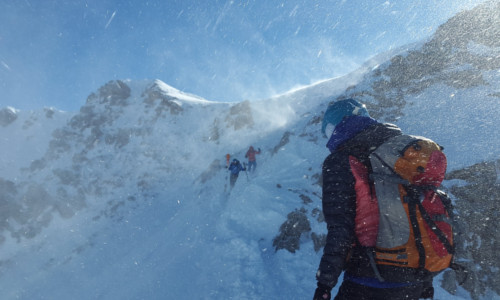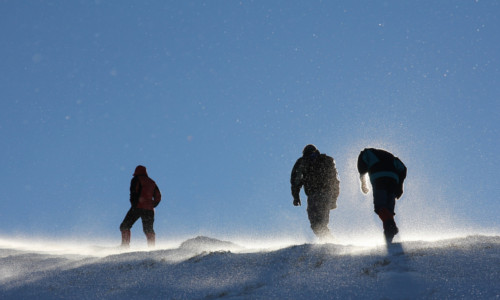Keep Yourself Warm in Freezing Temperatures With These 5 Tips
Author

Chris shares his passion for cycling, hiking, skiing, and climbing from Buxton, in the Peak District. As a blogger for Outdoor Look, Chris shares outdoor tips and indoor tricks to help you get the most out of your time spent outside. When he's not out adventuring he's making videos or trying to keep up with his 4-year-old son.
 Due to my passion for skiing, I've spent a lot of time in freezing weather. Over the years, I have enjoyed my time in the wide expanses and snow-covered mountains, and also faced my share of problems due to the hazards of below-freezing point temperature. I have learned many lessons, none more important than being ready for the inclement weather and difficult elements. If you are in the habit of spending a lot of time on snow during your winter holidays, it becomes essential that you take necessary precautions in order to safeguard yourself against the elements.
Due to my passion for skiing, I've spent a lot of time in freezing weather. Over the years, I have enjoyed my time in the wide expanses and snow-covered mountains, and also faced my share of problems due to the hazards of below-freezing point temperature. I have learned many lessons, none more important than being ready for the inclement weather and difficult elements. If you are in the habit of spending a lot of time on snow during your winter holidays, it becomes essential that you take necessary precautions in order to safeguard yourself against the elements.
1. Make a Habit of Staying Warm
No matter what the situation is, always look to find a way to keep yourself warm. When in a car on your way to the resort, turn the heating up and try to warm your clothes. If you find yourself stranded, use a lighter to keep your hands toasty. And in case you are lucky enough to find some dry wood, light a fire and cherish the warm moments, as they will be few and far between on your snowy excursion.
2. Find the Right Layers
Layered clothing dress up is ideal for beating the chilly weather. Begin with a base layer, preferably made from wool or synthetic, and put other layers on top of that. Always stick to wool or synthetic for the first layer. As I like to switch between activities on my snow trips, I regularly customize the layers under my insulated jacket. Generally, there are three layers that one should wear for a warm experience in extremely cold climate. However, you should dress as per your preferences. If you like to stick to high-octane activities like snow shoeing and skiing, you should opt for lightweight fabrics and sometime skip the middle layer. However, keep an extra lightweight puffy jacket in your bag to beat the cold when the mercury drops suddenly.
3. Understand the Elements and Know the Signs
 Cold weather can turn nightmarish when the wind picks up. The wind can send mercury way below zero, which can be quite hazardous and cause hypothermia. Knowing the symptoms and signs of hypothermia can go a long way in preventing its onset and nipping it in the bud. The first symptoms of hypothermia include shivering, clumsiness, confusion, and slurred speech. If you catch the signs early, then it becomes easier to tend to the patient and save a life. If you start feeling sluggish, eat some food and keep on moving. Also wrap yourself with an extra jacket to stay warm and toasty.
Cold weather can turn nightmarish when the wind picks up. The wind can send mercury way below zero, which can be quite hazardous and cause hypothermia. Knowing the symptoms and signs of hypothermia can go a long way in preventing its onset and nipping it in the bud. The first symptoms of hypothermia include shivering, clumsiness, confusion, and slurred speech. If you catch the signs early, then it becomes easier to tend to the patient and save a life. If you start feeling sluggish, eat some food and keep on moving. Also wrap yourself with an extra jacket to stay warm and toasty.
4. Spare Some Room for Your Toes to Wiggle
If you are in the habit of fitting your ski boots as tightly as you could, then I recommend that you ease off on this practice. Tight boots worn for a long time on snow can cause frost-nipped toes. Whether you like to ice climb or ski tour, it is always better that you size up a half or even a full size; which will provide wiggle room for your toes and help with blood circulation.
5. Pack Heat in Your Backpack
When the cold becomes unbearable, it is always reassuring to have a couple of warmers in your backpack. Disposable hand, toe, and body warmers can bring respite to the freezing body parts quickly. With these warmers you will be able to keep your fingers flexible, which are essential for performing basic tasks in the snow. You can even cover your phone in the warmer to extend the battery life as the battery dies quicker in the cold.
Author

Chris shares his passion for cycling, hiking, skiing, and climbing from Buxton, in the Peak District. As a blogger for Outdoor Look, Chris shares outdoor tips and indoor tricks to help you get the most out of your time spent outside. When he's not out adventuring he's making videos or trying to keep up with his 4-year-old son.
- Speed Up Your Post-Hike Recovery with These 6 Essential Tips
- Cycling through Tranquil Roads and Coastal Views on the Isle of Wight
- The Essential Guide to Hiking Safety: 5 Tips Every Hiker Should Know
- Run Smart, Run Strong: Your Guide to Injury-Free Running
- Embrace Biking: Essential Tips for Beginners
Categories
- Sport (28)
- Product Reviews (3)
- Team Outdoor Look (7)
- Mike Wild (2)
- Mike Payton (2)
- Suse Hammond-Pears (3)
- Snowboarding (12)
- Latest Offers (105)
- Shop Talk (1)
- Competitions (7)
- Walking (413)
- Lifestyle Fashion (8)
- Travel (86)
- Kit Guides (176)
- Workwear Clothing (6)
- Safety Workwear (4)
- Health/Fitness (289)
- Skiing (91)
- Great Outdoors (1316)
- Cycling (92)
- January 2025
- December 2024
- November 2024
- October 2024
- September 2024
- August 2024
- July 2024
- June 2024
- May 2024
- April 2024
- March 2024
- February 2024
- January 2024
- December 2023
- November 2023
- October 2023
- September 2023
- August 2023
- July 2023
- June 2023
- May 2023
- April 2023
- March 2023
- February 2023
- January 2023
- December 2022
- November 2022
- October 2022
- September 2022
- August 2022
- July 2022
- June 2022
- May 2022
- April 2022
- March 2022
- February 2022
- January 2022
- December 2021
- November 2021
- October 2021
- September 2021
- August 2021
- July 2021
- June 2021
- May 2021
- April 2021
- March 2021
- February 2021
- January 2021
- December 2020
- November 2020
- October 2020
- September 2020
- August 2020
- July 2020
- June 2020
- May 2020
- April 2020
- March 2020
- February 2020
- January 2020
- December 2019
- November 2019
- October 2019
- September 2019
- August 2019
- July 2019
- June 2019
- May 2019
- April 2019
- March 2019
- February 2019
- January 2019
- December 2018
- November 2018
- October 2018
- September 2018
- August 2018
- July 2018
- June 2018
- May 2018
- April 2018
- March 2018
- February 2018
- January 2018
- December 2017
- November 2017
- October 2017
- September 2017
- August 2017
- July 2017
- June 2017
- May 2017
- April 2017
- March 2017
- February 2017
- January 2017
- December 2016
- November 2016
- October 2016
- September 2016
- August 2016
- July 2016
- June 2016
- May 2016
- April 2016
- March 2016
- February 2016
- January 2016
- December 2015
- November 2015
- October 2015
- September 2015
- August 2015
- July 2015
- June 2015
- May 2015
- April 2015
- March 2015
- February 2015
- January 2015
- December 2014
- November 2014
- October 2014
- September 2014
- August 2014
- July 2014
- June 2014
- May 2014
- April 2014
- March 2014
- February 2014
- January 2014
- December 2013
- November 2013
- October 2013
- September 2013
- August 2013
- July 2013
- June 2013
- May 2013
- April 2013
- March 2013
- February 2013
- January 2013
- December 2012
- November 2012
- October 2012
- September 2012
- August 2012
- July 2012
- June 2012
- May 2012
- April 2012
- March 2012
- February 2012
- January 2012
- December 2011
- November 2011
- October 2011
- September 2011
- August 2011
- May 2010
- April 2010
- March 2010
- February 2010
- January 2010
- November 2009
- October 2009
- September 2009
Submit a Comment